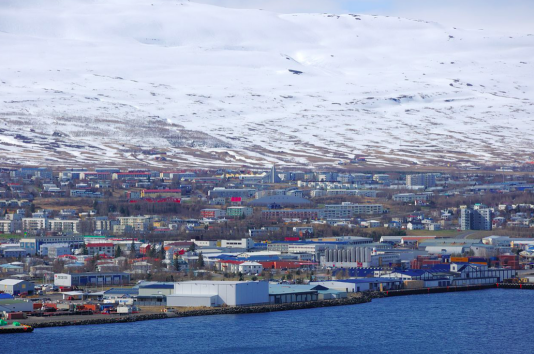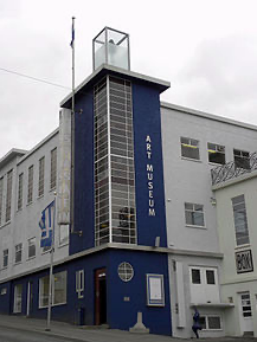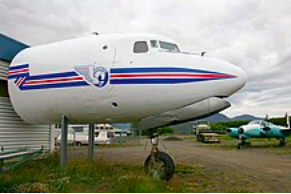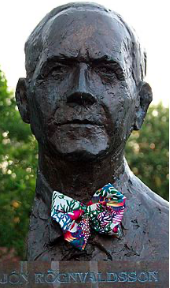Akureyri, Iceland 作者: 来源: 发布时间:2021-01-14
一、人口,面积
Akureyri is a town in northern Iceland. It is Iceland's fourth-largest municipality, after Reykjavík, Hafnarfjörður, and Kópavogur, and the largest town outside Iceland's heavily populated southwest corner. Nicknamed the "Capital of North Iceland", Akureyri is an important port and fishing center. The area where Akureyri is located was settled in the 9th century, but did not receive a municipal charter until 1786. Allied units were based in the town during World War II. Further growth occurred after the war as the Icelandic population increasingly moved to urban areas. The area has a relatively mild climate because of geographical factors, and the town's ice-free harbor has played a significant role in its history.

On January 1, 2015 Akureyri had a population of 18,191; of whom 9,011 were males and 9,180 were females. About 3% of the population are foreign citizens, from 53 different countries. In 2014 there were 229 births and 118 deaths in Akureyri. Immigration in 2014 was 1,097 individuals, while emigration was 1,122 residents. Population growth in 2014 was therefore 0.5%. The population in 1910 was 2,239, increasing to 7,711 in 1950 and 16,756 in 2005.
二、自然地理
1.地理条件
Akureyri is located at 65 ° 41′N 18 ° 06′WCoordinates: 65 ° 41′N 18 ° 06′W and positioned on the west side of the inland end of the fjord Eyjafjörður. It is surrounded by mountains, the highest being Kista (1,447 m (4,747 ft)); 10 kilometers (6.2 miles) to the west) and Kerling (1,538 m (5,046 ft)) at the head of Glerádalur, 15 km (9.3 mi) to the southwest. It has a narrow coastal strip of flat land; inland is a steep but low hill. In earlier times, a few spits of land (Icelandic: eyri, thus Akur-eyri) jutted from the narrow coast, but much land has since been reclaimed from the sea, so that today the coastline is more even except for the largest spit, Oddeyri, which was formed by the river Glerá, which runs through the town. The name of the town is possibly derived from the name of a field that may have been situated near some of the sheltered locations by the river. The area around Akureyri has one of the warmest climates in Iceland, even though it is only 100 km (62 mi) from the Arctic Circle.
2. 交通情况
Akureyri Airport, one of four international airports in Iceland and the only international airport in the north of the country, was constructed in 1955 replacing the airstrip at Melgerdismelar further to the south. The current airport is mostly used for domestic flights, with seasonally scheduled international flights. Air Iceland flies several times a day to Reykjavík, and there are also domestic flights to Grímsey (a small island to the north) and to Vopnafjörður and Þórshöfn (both small settlements in northeast Iceland).
In 2007, Akureyri Airport had a passenger traffic level of 221,200 and 19,778 aircraft movements. The port of Akureyri is vital to the town, which largely bases its livelihood on fisheries. It is the site of large fish processing plants and has docking facilities for trawlers. It is also important for freight handling and for tourism, as cruise ships stop in Akureyri during the summer months. The ice-free nature of the port has been important in the town's establishment.
SBA-Norðurleið (Icelandic Bus Company - northern route) is an Akureyri-based company that provides a long-distance bus service to the town. Local bus services within Akureyri are provided by the SVA (Akureyri Bus Company), which does not charge fares. The cessation of fares in 2008 resulted in an increase of 130% in passenger numbers compared to the previous year when fares were charged.
Route 1 or the Ring Road (Þjóðvegur 1 or Hringvegur) connects the town with the other parts of the country, including Reykjavík, which is 390 kilometers (242 miles) away. The road is mostly one lane in each direction, but is paved and open year-round. There are no paved roads from Akureyri to the unpopulated interior of the island. However, the F821 mountain road is open in summer: it climbs southwards from Akureyri and connects with the F26 mountain road across the interior to the SW of the country. Parking in the central area requires use of a parking disc indicating the time that parking has commenced. Parking is free but is limited in certain areas to a maximum period ranging from 15 minutes to 2 hours.
三、经济发展和规模(当地GDP等)
Two of the five largest fishing companies in Iceland are headquartered in Akureyri, partly because of the ice-free port. [4] Other large companies in Akureyri include Samherji, Norðurmjólk, Brim hf, and Vífilfell, the largest brewery in Iceland. Sjúkrahús Akureyrar (FSA / Akureyri Hospital) is a major employer in the area and is one of two major hospitals in Iceland. Corporations pay a tax rate of 18% to the national government, which is one of the lowest in the world. No additional local corporate taxes are levied. Property tax, at 1.99%, accounts for most of the tax base. A local government deficit of ISK 1 billion (US $ 9 million) was anticipated in 2009, prompting a cut in salaries of the mayor, town councilors, and committee members by 10% and increases in local taxes and property taxes.
Akureyri is governed by a town council, directly elected by those over 18 with registered domicile in the town. The council has 11 members, who are elected for four-year terms. The mayor is appointed by the council: usually one of the council members is chosen, but they may also appoint a mayor who is not a member of the council.
The last elections to the town council were held on May 31, 2014. The People's List (Listi fólkins), which won an outright majority in 2010, and The Town List (Bæjarlistinn) merged into L-list, the Town List of Akureyri. They had seven representatives together, but now have only two, 18.8%. The Independence Party (Sjálfstæðisflokkurinn) received the most votes, three seats in the council, 25.8%, instead of only one previously. The Social Democratic Alliance (Samfylkingin) and Progressive Party (Framsóknarflokkurinn) each got two seats instead of the previous one each. Left-Green Movement and Bright Future each got one seat. L-list, Social Democratic Alliance, and Progressive Party formed a new majority in the council. The new majority decided that Eiríkur Björn Björgvinsson, mayor of Akureyri since 2010, would continue to serve as mayor.
The Finance Department oversees the accounting and finances of Akureyri, handles planning, next year's budget, three-year plan, long-term plans and monitors expenses. The division provides financial information to town representatives, managers and employees of Akureyri, handles administrative audits and assists managers in operational audits, and ensures that the accounts of Akureyri and institutions are kept in a timely manner and in accordance with laws and regulations.
The main tasks of the finance department are to pay the submitted invoices from the town's creditors, and to create and send out invoices for all the departments of the town. In addition to collecting invoices, managing cash flow in and out of the town's bank accounts as well as liaising with the town's creditors and customers. The Finance Department handles the procurement, tendering and contracting of various consumables, as well as the compilation, processing and dissemination of various statistics and statistics on the town's operations. The Finance Division strives to provide customers and colleagues with good service, meet deadlines and ensure that the accounts provide clear information to management.
The accounting department is responsible for receiving and registering invoices, accounting, reconciliations and settlements for the town's fund and its institutions. The accounting department also oversees the operation of the town's accounting system and prepares VAT settlements, handles various reports and submits information to Statistics Iceland and public institutions. In addition, the accounting department assists users of the accounting system and guides them as needed along with numerous other tasks.
四、产业特点重点项目
The guiding light of the planning department is to work for the interests of the townspeople through quality and professional work. Use building inspections as consumer protection to ensure the quality of buildings. Create a diverse and high-quality living environment, emphasize the special features of the town with high-quality design and the preservation of any kind of cultural heritage. Based on environmental protection, ecosystem protection and sustainability standards. Promote the rational and efficient utilization of land and land quality, ensure the preservation of natural and cultural values and prevent environmental damage and overexploitation or excessive pressure on the ecosystem in the municipality.
The main tasks of the planning department are planning and construction. Construction matters include the review of drawings and design documents, the issuance of building permits and building inspections on the basis of the Act on Structures no. 160/2010. In addition, registration of plots and real estate, cooperation with other departments of the town, companies and institutions regarding planning issues, etc., comments on planning-related issues, introductory meetings and information. The main tasks of the planning department are planning and construction. Planning issues include the processing and supervision of the municipality's master plan, local planning districts, environmental planning, traffic planning and participation in the preparation of regional planning. Akureyri's master plan 2018-2030 lays down lines and is decisive for land use.
The administrative department provides various external and internal services as well as support services for other areas of the municipality. There are three departments on the stage; information and services department, payroll department and human resources department. The division handles payroll and wage issues, human resources and documentation of the municipality, as well as services and information to town representatives, councils and committees, residents, companies, institutions, managers and other employees. The Administration Division is a leader in the field of reform in the field of quality and e-government and services.
The role of the payroll department is payroll processing and payroll payments to employees of Akureyri in accordance with current wage agreements, laws and rules and articles of association of Akureyri. Central services are provided to managers and employees, information and counseling to employees and managers, education and training of managers, supervision, interpretation and implementation of wage agreements.
The Human Resources Department provides advice and support in human resources-related matters, is responsible for and oversees attendance systems, central education, job application and job advertisement, staff website, management and staff manuals, management and assistance for job evaluation, responsibility for conducting employee surveys, assistance with job registration documents to relevant agencies.
The information and service department is one of three departments within the administrative department of Akureyri. The department provides a variety of services, e.g. with the mayor, elected representatives, town council, town council and committees, the town's employees and the residents of Akureyri. The department includes an archive, web management with the website of Akureyri, electronic administration, service lobby, office of Akureyri in Hrísey, operation of the Town Hall and the office building at Glerárgata 26, housekeeping, operation of a canteen for Ráðhús and Glerárgata 26 staff and communication with Hverhverfnið 26.
The stage employs just over 100 people and is in charge of all real estate, streets and open areas owned by the town. Its main tasks are new construction, purchase and sale of properties, maintenance of properties and their leasing. Also the daily management of the town's construction. This includes the design and measurement, construction and maintenance of streets and sidewalks, street lighting, garbage collection, snow removal, gardens and open areas and the fire brigade.
五、风景名胜,景点( attractions)
1. Akureyri Art Museum

The Akureyri Art Museum was founded in 1993. The museum is located in the center of Akureyri, the second-largest city in Iceland. Originally home to a dairy, the building which houses the gallery is noted as a good example of the Bauhaus school of architecture.
Artists that have had their work displayed in the Akureyri Art Museum include Icelandic artists Erró, Kjarval and Louisa Matthíasdóttir, American artist Spencer Tunick, Israeli video artist Guy Ben-Ner and French photographer Henri Cartier-Bresson. The museum has been host to the Icelandic Visual Arts Awards since 2006, when they were first given.
2. Aviation Museum of Iceland

The Aviation Museum of Iceland covers the history of aviation in Iceland. It is housed at Akureyri Airport and was formally opened on 24 June 2000. The museum was founded on 1 May 1999 and formally opened on 24 June 2000 by Halldór Blöndal, the Speaker of the Althing. It was initially known as the Aviation Museum at Akureyri; another aviation collection existed at Hnjótur in Örlygshöfn. It was renamed in 2005 to reflect its national role. Svanbjörn Sigurðsson, a principal figure in the foundation of the museum, was its first director.
Initially in temporary quarters in a hangar rented by Íslandsbanki, the museum moved in 2007 to a purpose-built building with 2,200 square meters (24,000 sq ft) of space, approximately five times what it previously had; the building was officially opened by Sigrún Björk Jakobsdóttir, the mayor of Akureyri. It celebrated its tenth anniversary in 2009. The aircraft collection has been used for training by the Icelandic Technical School.
The museum has many photographs of Icelandic aviation through the years and also a number of historic aircraft, many of which it maintains in airworthy condition and flies at least once a year on an annual fly day. These include: Klemm L.25e TF-SUX, built in 1934 and brought to Iceland by Germans in 1938; the first plane to land in the Vestmannaeyjar, Waco YKS-7 identical to TF-ÖRN, the first aircraft operated by Flugfélag Akureyrar, later Flugfélag Íslands, when it began service in 1938, a twin-engine Beechcraft identical to that first brought to Iceland in 1942, Björn Pálsson's Auster V, with which he flew the first air ambulance service in Iceland, a 1943 Douglas DC-3 that saw duty at Keflavík Air Base before transfer to civilian use by Flugfélag Íslands in 1946, the cockpit of Gullfaxi, Boeing 727 TF-FIE, the country's first jet aircraft, recovered from the Mojave Desert, Aérospatiale SA-365N-1 Dauphin 2 TF-SIF, a Coast Guard rescue helicopter that was in service for 22 years before being damaged in a training exercise in 2007.
3. Akureyri Botanical Garden

The Akureyri Botanical Garden is located at 65 ° 40′30 ″ N 18 ° 05′36 ″ WCoordinates: 65 ° 40′30 ″ N 18 ° 05′36 ″ W and positioned on the west side of the inland end of the fjord Eyjafjörður at about 45 meters elevation. It is located in the southern part of the city of Akureyri in Northern Iceland, 50 kilometers south of the Arctic Circle. It is remarkable for its extreme location.
In 1910, women from Akureyri founded the Park Association to beautify their city. The previous year the city had given them a hectare of land. The garden, the first public park in Iceland, was headed until 1953 by the Park Society. During this time the garden area increased to 3.6 hectares. Besides being a place of peace and tranquility the garden is a place for scientific research. It has proven that shrubs, trees and other plants can survive on the edge of the Arctic. Jón Rögnvaldsson's plant collection was purchased by the city in 1957. Rögnvaldsson was a leading force in the garden for many years, along with Margarethe Schiöth. Both of them are represented by busts in the garden, along with Akureyri clergyman Matthias Jochumsson, the poet of the Icelandic national anthem. Besides arctic plants, those from the temperate zones and high mountains are grown. Icelandic plants are represented by about 400 species in the southeastern corner of the garden. By the end of 2007, there were about 7000 species. In the garden there are public toilets. The entrance to the garden is free, and it is always open. The garden contains a few wooden houses, of which Eyrarlandsstofa is one of the oldest in Akureyri.
六、历史文化
1.历史
The Norse Viking Helgi magri (the slim) Eyvindarson originally settled the area in the 9th century. The first mention of Akureyri is in court records from 1562, when a woman was sentenced there for adultery. In the 17th century, Danish merchants based their camps at the current site of Akureyri, which was one of the numerous spits of land in Pollurinn. The main reasons for choosing this spot for trading operations were the outstanding natural harbor and the fertility of the area. The merchants did not live at Akureyri year-round, but returned home in the winter.
Permanent settlement at Akureyri started in 1778, and eight years later, the town was granted its municipal charter by the king of Denmark (and at the time Iceland also) along with five other towns in Iceland. The king hoped to improve the living conditions of Icelanders by this action, because at the time, Iceland had never had urban areas. As far as the king was concerned, Akureyri was unsuccessful, because it did not grow from its population of 12. It lost its municipal status in 1836, but regained it in 1862. From then on, Akureyri grew because of the excellent port conditions and perhaps more because of the productive agricultural region around it. Agricultural products became an important sector of the economy. Akureyri, with Hlíðarfjall behind, viewed from the eastern shore of Eyjafjörður, morning November 2007.
During World War II, Akureyri was one of three air bases used by the Norwegian-British No. 330 Squadron RNoAF. The squadron, which was formed on 25 April 1941, flew Northrop N-3PB bombers: 'A' flight was based at RAF Reykjavik, 'B' flight at Akureyri and 'C' flight at Budareyri (Reyðarfjörður now). On 1 December 1940, 'A' and 'B' flights ceased operating from Norwegian bases, but 'C' flight continued to fly Northrop N-3PBs from Akureyri until 5 April 1943. No. 330 Squadron RNoAF also operated Catalina flying boats from Akureyri, which protected convoys between the United States, the United Kingdom, and Murmansk in northern Russia from attack by German submarines.
In the 20th century, Iceland experienced an exodus from the countryside to the towns. Commerce and service industries grew to be the primary employers in Akureyri in the 1990s. Jón Sveinsson, a popular author of children's books, was born in Akureyri and died in 1944.
In the early 21st century, fishing industries have become more important in Akureyri as two of the major fishing companies of Iceland have become a more important source of revenue and are expected to grow further in coming years. The University of Akureyri was founded in 1987 and is growing rapidly.
Since 2004, the former municipality of Hrísey, an island 35 km (22 mi) to the north, has been a part of Akureyri. Hrísey, which has a population of 210, is the second-largest island off Iceland and is a site for pet and livestock quarantine. The settlement was previously the site of fishing processing. The town is located on the southern part of the island. The northern part consists of privately owned land that requires passes to enter.
2. 文化体育
Akureyri has a robust cultural scene, with several bars and reputable restaurants (such as "Greifinn", "Bautinn", "RUB 23 Steak / Sushi", "Kung Fu sushi bar" and "Götubarinn"). The Icelandic folk dance ensemble "Vefarinn" comes from Akureyri. Folk culture in general is more prevalent in Akureyri than in Reykjavík. During the summer, several festivals are held in Akureyri and the surrounding area. One example is the medieval festival held every summer at Gásir. The Akureyri International Music Festival, a concert series by bands, was held for the fourth time in 2009. The town has one of the largest libraries in the country.
The Vikudagur newspaper is published in Akureyri. The Icelandic National Broadcasting Service (Ríkisútvarpið) operates two radio channels nationwide. The several radio stations in Akureyri include FM Akureyri and Voice FM 98.7. Several television stations can be watched in Akureyri. N4 is a station whose studios are located in Akureyri. Initially a local channel, it began to broadcast nationwide in 2008.
There are two high schools (gymnasiums) in Akureyri, one of them being the second oldest in Iceland. The Menntaskólinn á Akureyri is a junior college in Akureyri and so is the Verkmenntaskólinn á Akureyri (Akureyri Vocational College). The University of Akureyri (Háskólinn á Akureyri) was founded in 1987. There are 3 faculties or colleges, the Faculty of Business and Science, Faculty of Humanities and Social Sciences and Faculty of Health Sciences. The university offers master's degrees in several subjects.
The Akureyri Football Club (KA) and Þór Akureyri are the two biggest multi-sport clubs in the town. They field teams in several sports, such as basketball, football and handball. The most successful football team of late in the town has been Þór / KA, a joint women's team from KA and Þór. Since 2008, it has finished in the top four in the top-tier Women's Premier League, winning the national championship in 2012 and 2017. The clubs also have two men's football teams under their own names. The clubs field a joint team in women's handball, KA / Þór. They fielded a joint men's team under the name Akureyri Handboltafélag from 2016 to 2017 before KA broke off from the cooperation and fielded a separate team in 2017–2018.
In basketball, Þór fields both men's and women's team. Its women's team has won the national championship three times; in 1969, 1971 and 1976. The town's ice hockey team, Skautafélag Akureyrar, is the most successful team in the history of the Icelandic Hockey League, with 20 championships from 1992 to 2018. The Akureyri Golf Club is the second oldest golf club in Iceland behind The Reykjavík Golf Club. It was established in 1935 and is the annual location of The Arctic Open held each summer solstice. The town is also the birthplace of Icelandic footballers Birkir Bjarnason and Aron Gunnarsson, as well as mixed martial arts fighter Gunnar Nelson.
七、其他信息
Crime statistics have been published by the Iceland national police for 2000. Akureyri had a reported 726 nontraffic offenses per 10,000 population compared with a national average of 892, while 2,891 traffic offenses per 10,000 population were recorded compared with a national average of 2,397. Akureyri has five police officers on call. Incidents have occurred where insufficient police officers were on duty to respond to criminal activity in progress, as confirmed by the mayor. However, Akureyri, and Iceland in general, has one of the lowest crime rates in the world.
八、联系方式
Town Manager: Ásthildur Sturludóttir
Phone:460 1000
Email:evamaria@akureyri.is
Address:Geislagata 9 600 Akureyri
https://www.akureyri.is/is/thjonusta/velferd-og-fjolskyldan/althjodastofa
